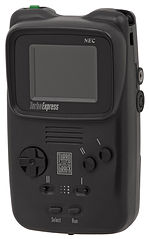
Turbo Grafx Express
The TurboExpress was a portable version of the TurboGrafx, released in 1990 for $249.99 (the price was briefly raised to $299.99, soon dropped back to $249.99, and by 1992 it was $199.99). It was the most advanced handheld of its time and could play all the TG-16's HuCard games five years before the Sega Nomad could do the same for Sega Genesis games. Its Japanese equivalent was the PC Engine GT. It had a 2.6-inch screen, the same as the original Game Boy. It shared the capabilities of the TurboGrafx, giving it 512 available colors (9-bit RGB), stereo sound, and the same custom CPU at 7.16 MHz. The optional "TurboVision" TV tuner included RCA audio/video input, allowing the user to use TurboExpress as a video monitor. The "TurboLink" allowed two-player play. Falcon, a flight simulator, included a "head-to-head" dogfight mode that could only be accessed via TurboLink. However, very few TG-16 games offered co-op play modes especially designed with the TurboExpress in mind.
TurboExpress: The Power of the TurboGrafx-16 in Your Hands
Released in 1990, the TurboExpress (known as the PC Engine GT in Japan) was an ambitious handheld console developed by NEC. Essentially a portable version of the TurboGrafx-16, it stood out by being one of the most powerful handhelds of its time, capable of playing the same HuCard cartridges as its home console counterpart-something no other major handheld was doing at the time.
Sporting a 2.6-inch backlit color LCD screen, the TurboExpress offered crisp and vibrant visuals far beyond competitors like the Game Boy. It also featured a d-pad, two action buttons, and turbo switches, making it ideal for fast-paced arcade-style gameplay. However, its biggest drawback was battery life-the system required six AA batteries, which drained in just 2-3 hours.
For added versatility, NEC released the TurboVision TV tuner accessory, allowing users to watch live television on the device, further pushing its multimedia appeal. However, due to its high price (around $299 at launch) and limited third-party support, the TurboExpress struggled against cheaper handhelds like the Game Boy.
Today, the TurboExpress is considered a cult classic among collectors, admired for its ambitious design, sharp graphics, and ability to play full home console games on the go-a concept that was ahead of its time.


